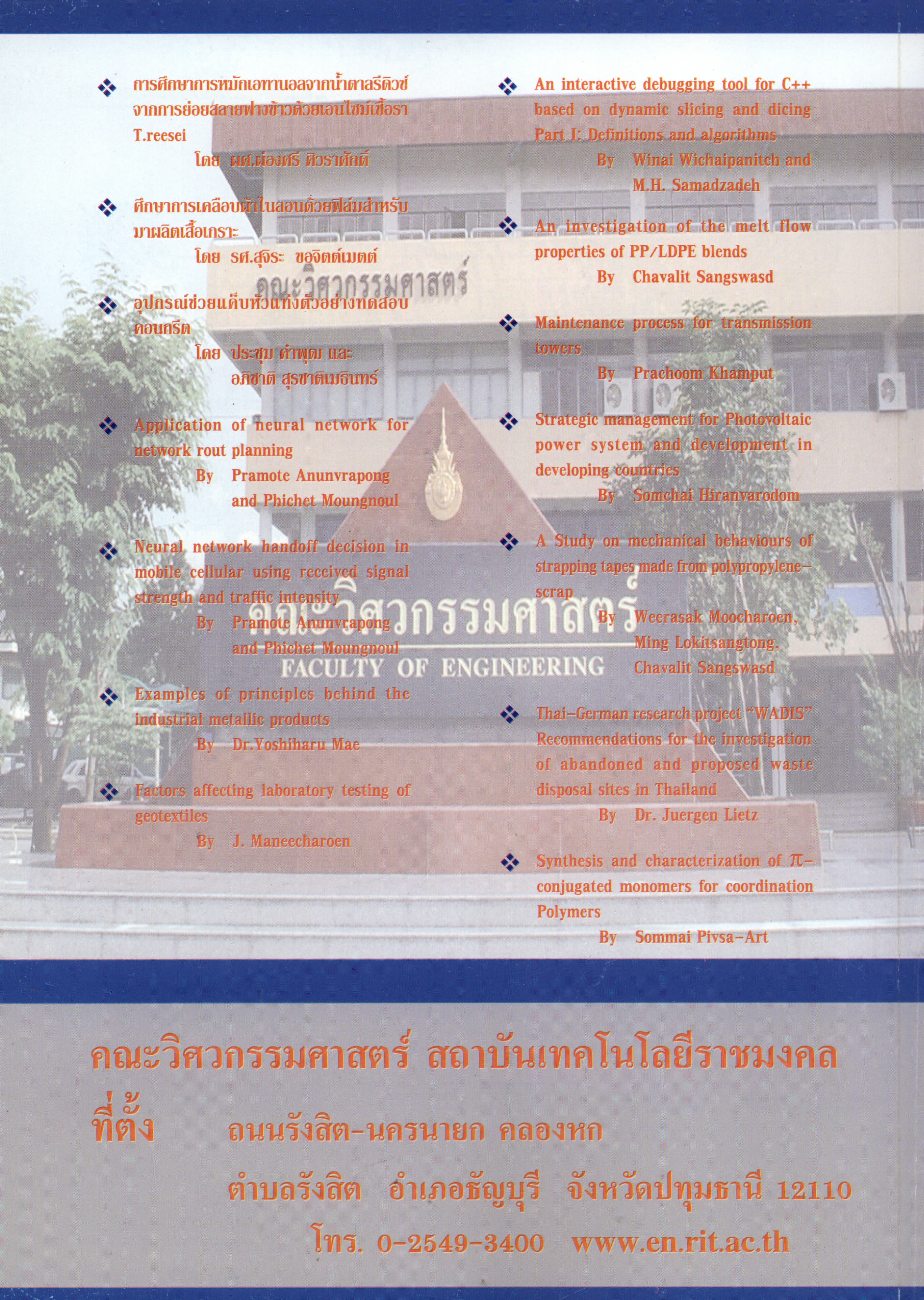Factors affecting laboratory testing of geotextiles
Main Article Content
Abstract
In order to investigate the factors affecting index and engineering properties of a specific geotextile, different tests were conducted using both heat-bonded nonwoven and needle-punched nonwoven geotextile, namely: apparent opening size (AOS), wide-width tensile strength, permittivity , transmissivity, and puncture resistance. The effect of humidity on the pore size of the samples have been investigated. To check whether the clamping system has an effect on the strength of geotextiles, over 240 tests were conducted. The presence of air bubbles in water and its effect on the permittivity and transmissivity of geotextiles were also verified. Also investigated were the effects of higher strain rate on the tensile strength and puncture resistances. The results indicate that decreasing humidity slightly increased the AOS; higher strain rate and the use of hydraulic clamp increased the wide-width tensile strength; using de-aired water largely improved the permittivity and transmissivity; and increasing the strain rate decreased the puncture resistance. The effects of humidity and oxygen content were more pronounced and obvious in the case of needle-punched geotextile compared to heat-bonded nonwoven geotextile.
Article Details
The manuscript, information, content, picture and so forth which were published on Frontiers in engineering innovation research has been a copyright of this journal only. There is not allow anyone or any organize to duplicate all content or some document for unethical publication.
References
wide-width strip method. Annual Book of ASTM Standards. Section 4. 4(9):38-45
ASTM 4833-88 (1994). Standard test method for index puncture resistance of geotextiles.
geomembranes and related products. Annual Book of ASTM Standards Section 4. 4(9);65-68.
ASTM D4716-87 (1994). Standard test method for constant head hydraulic transmissivity (inplane flow) of geotextiles and geotextile related products. Annual Book of ASTM Standards Section 4. 4(9):53-56.
ASTM D4751-93 (1994). Standard test method for determining apparent opening size of a
geotextile. Annual Book of ASTM Standards,Section 4. 4(9):57-61.
Bhatia, S. K., Huang, Q, and Hawkins, W. M. (1995). The soil-geotextile interface stability
under sudden change in hydraulic condition.Geosynthetics International. 2:297-315.
Cancelli, A., Cazzuffi, D., and Rimodi, P. (1987),Geocomposite drainage system: mechanical properties and discharge capacity evaluation.Proceedings of the Geosynthetic Conference.New Orleans, USA: 3 93 -404.
Faure, Y. H,, Gourc, J. P, and Gendrin, P. (1990).Structural study of porometry and filration
opening size of geotextiles. Geosynthetics Microstructure and Performance. ASTM ST?
1076. 1. D. Peggs, Editor. Philadelphia:102-119.
Gerry, B. S, and Raymond, G. P. (1983).Equivalent opening size of geotextiles.Geotechnical Testing Journal. 6(2):53-63.
Halse, Y. H., Lord. A. E. and Koemer, R. M.(1988). Effect of dissolved oxygen (and bubbles) on the measured permittivity of geotextiles. Geotechnical Testing Journal. 11(2):158-160.
Hwu, B. L., Koemer, R. M., and Sprague, C. J.(1990). Geotextiles intrusion into geonets. Proceedings of the Fourth International Conference on Geotextiles, Geomembrane and
Related Products. The Hague, Netherlands,A.A. Balkema, Rotterdam: 351-356.
Koemer, R. M., Monteleone, M. L, Schmidt, J. R. and Roethe, A. J. (1986). Puncture and Impact Resistance of Geotextiles. Proceedings of the Third International Conference on Geotextiles. Vienna, Austria: 677-682.
Shrestha, S. C. and Bell, J. R. (1982). Wide strip tensile test of geotextiles. Proceedings Second International Conference on Geotextiles.Las Vegas, USA: 739-744.
Slocumb R.C., Demeny, D. D., and Luettich, S.M.(1986). Creep characteristics of drainage nets.Proceedings of Superfand' 86. Washington DC, USA.
Smith, A. D., and Kraemer, S.R. (1987). Creep of geocomposite drains. Proceedings of the
Geosynthetic Conference. New Orleans, USA:422-433.
US EPA (1989). Requirements for hazardous waste landfill design, construction, and closure.
Seminar Document EPA/625/4-89/022.Environmental Protection Agency, Office of Research and Development, Cincinati, USA.
Williams, N., Giroud, LP., and Bonaparte, R. (1984).Properties of plastic nets for liquid and gas
drainage association with geomembranes.Proceedings of the International Conference on Geomembrane. Denver, USA: 339-404.


